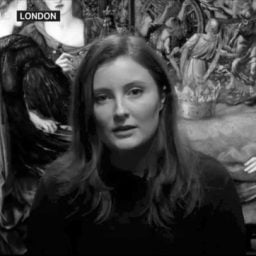Art & Exhibitions
Hew Locke on the Little Objects That Reveal a Big, Messy History at the British Museum
In "what have we here?," the Guyanese-British artist turns his probing eye toward the museum's own collection and the story it tells.

“You make up your own mind what to think.” Hew Locke’s voice arrives like a whisper out of nowhere, emanating from speakers suspended throughout his new show at the British Museum in London. The invitation is generous, assuring visitors that they are not here for a scolding. Rather, Locke hopes to start a “conversation,” albeit one that the U.K. has been putting off for as long as possible.
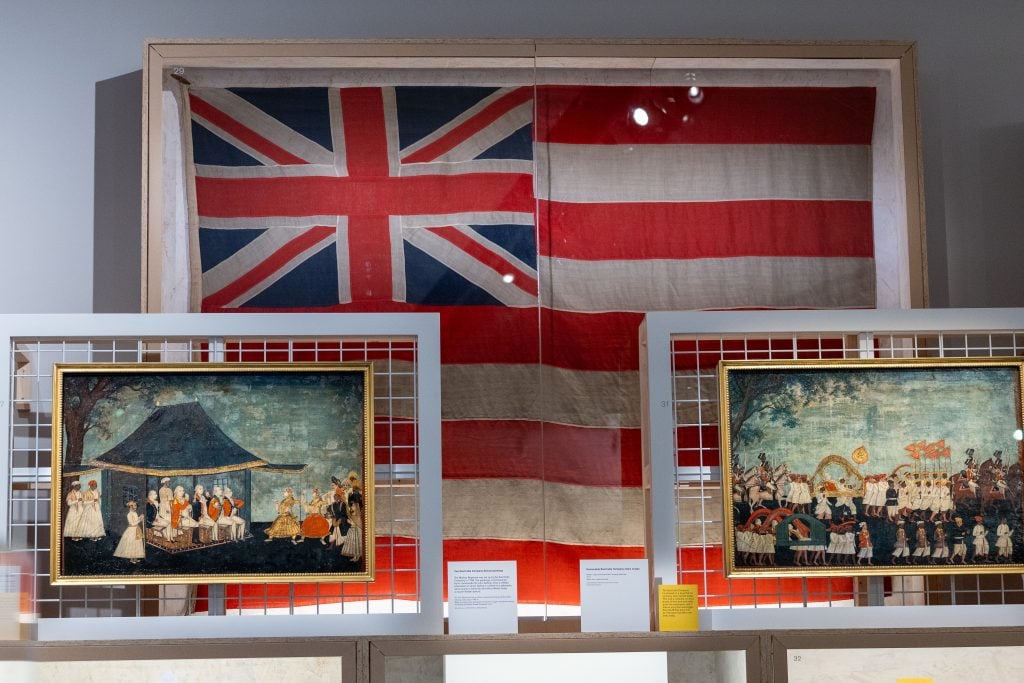
Grand Union Flag and paintings on display at the Hew Locke exhibition at the British Museum. Photo by Simon Ackerman/WireImage.
The British-Guyanese artist hardly need rely on dogma to get his point across. “Hew Locke: what have we here?” lacks the kind of strict narrative structure imposed on most museum shows. Instead, Locke has selected items from the British Museum’s Africa, India, and Caribbean collections; choice loans, and his own artworks to create a dense web of suggestive associations. Beyond this, the objects are left to speak for themselves.
“The exhibition is a collection of little stories that tell something really big,” said Locke ahead of the show’s opening on October 17. “Sometimes the objects may be very tiny.”
This is the case of each brass manilla that were produced in Europe and then used in Africa to buy goods, including enslaved people. Huge quantities were produced in the English city of Birmingham, and in some cases they were smelted down by artists in Benin to produce the Benin Bronzes that would later be looted back to England.

Lower Niger Bronze Industries bells, (900-1500) at “Hew Locke: what have we here?” at the British Museum. Photo by Simon Ackerman/WireImage
One takeaway is that many objects with what Locke calls “messy histories” defy age-old classification systems. For example, the Asante jug was made in England in the 1390s but later it made its way to Africa where it was a highly venerated object in the Asante royal court. It was photographed there in 1884 but, soon after this, returned to England as colonial loot. It has since been shown in the European Medieval galleries.
Traditional display methods had forcefully flattened objects like this into one dimension, but in Locke’s open-plan exhibition concept they are free to exist across multiple overlapping contexts.
While Locke has avoided including depictions of violence against people of color, it is heavily implied throughout the show. A particularly stark example is two ornamental brass discs that were looted along with thousands more sacred treasures from Benin City during a massacre by the British in 1897. These battered objects still bear the scorch marks from fires that destroyed the palace.
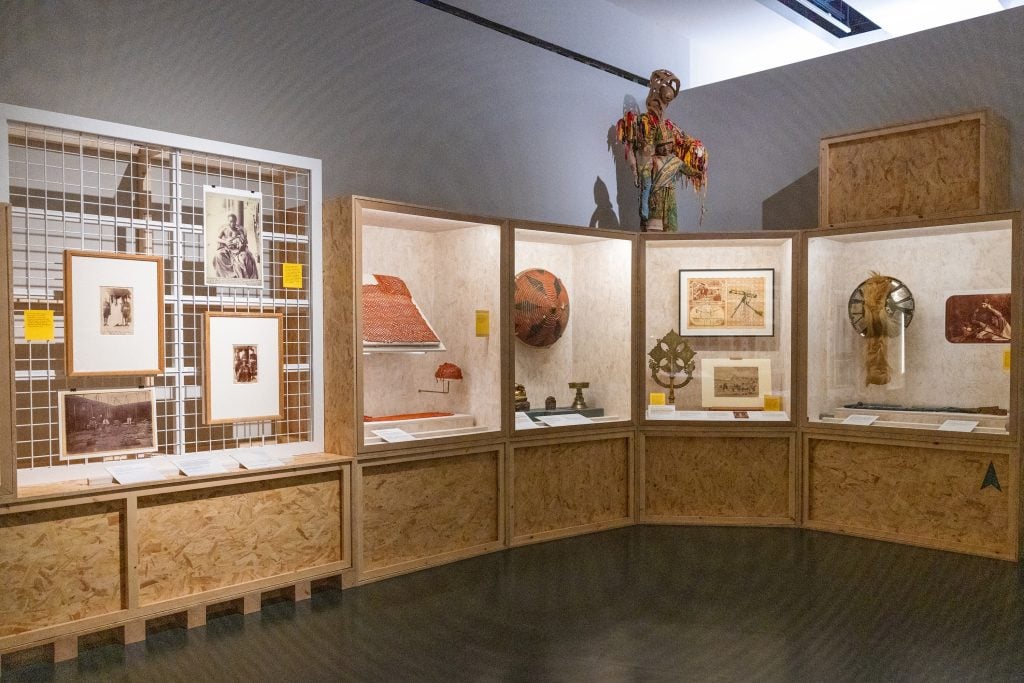
“The watchers” figures perched on top of installations at “Hew Locke: what have we here?” at the British Museum. Photo by Simon Ackerman/WireImage.
Some of Locke’s trademark extravagance and flair is expressed by new sculptures known as The Watchers, vibrantly dressed figures who peer down at the viewer with curiosity, observing our reactions. The artist himself also addresses visitors with his own yellow labels displayed beside official museum texts.
“My comments are very different, it’s my voice, my way of speaking,” he said. “I would hope that it’s easier to understand.” In some cases, these additions are a provocation, as in the case where Locke describes wood sculptures that the government of Jamaica has requested be repatriated as “Jamaica’s Elgin Marbles.”
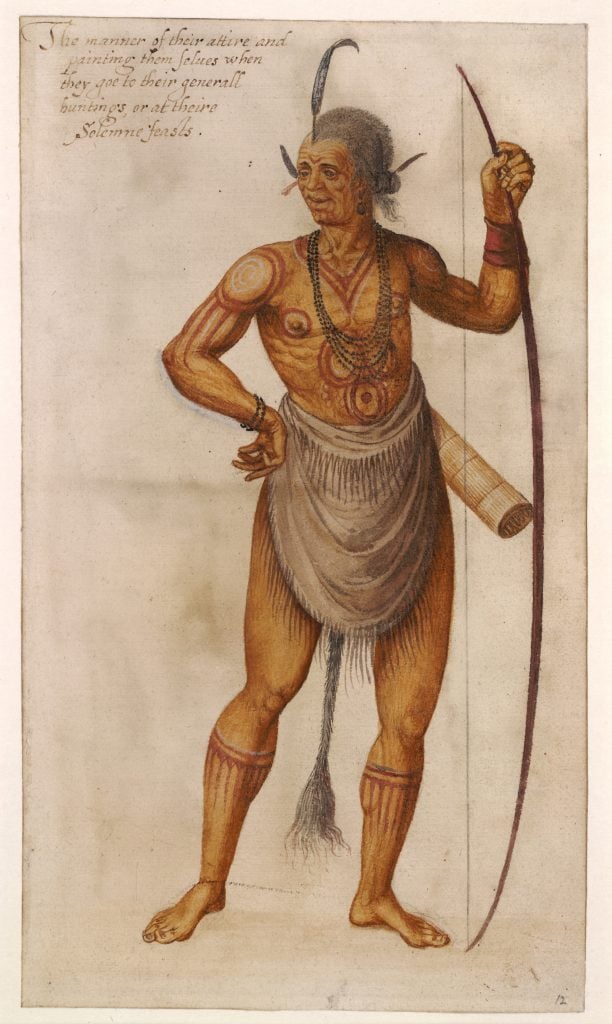
A North Carolina Algonquian werowance (leader) by John White. Photo: © The Trustees of the British Museum.
Some exceptionally rare drawings from the late 16th century by John White record but also exoticize North Carolina Algonquian people and present the “New World” as a land of plenty that is ripe for exploitation. Locke has exemplified the real world consequences of this by staging the works alongside objects like a Akawaio feather headdress and a necklace containing seven stuffed hummingbirds.
He also weaves in his own biography, noting in the wall text how he once travelled out of Guyana on a steamer filled with caged macaws and parakeets being “shipped out for the exotic pet trade. Every morning somebody would go through the cages and toss out the dead birds.”

Silver-gilt dish set with gold pendant at the Hew Locke exhibition in The British Museum. (Photo by Simon Ackerman/WireImage)
Born in Edinburgh in 1959, Locke moved to Guyana at the age of five, just in time to see the country gain independence in 1966. Witnessing the formation of a national identity via a new flag and anthem instilled in Locke a keen interest in symbolism and its relationship to power. He returned to the U.K. to study in the 1980, the same year he began regularly visiting the British Museum.
“What it felt like then was, this is a big establishment institution and I’m small,” said Locke. “There’s no place for me in this. I can appreciate it but it’s not anything that I can partake in.” And in more recent years? “Then it became, well, this is my stuff. I’m paying taxes. I own this. I have a share in it along with everybody else. This stuff is part of my heritage.”
Locke was an obvious pick for the British Museum, in what is clearly an effort to address the longstanding controversies around its collection without making any major concessions.
Over the past few decades, the artist has become a hit with museum audiences for his glittering spectacles that draw us in before redirecting our attention towards Britain’s colonial past. In 2006, he dressed a bronze statue of the slave trader Edward Colston—yes, the one torn down during a BLM protest in Bristol in 2020—in golden cowrie shells, which were once exchanged for enslaved Africans.
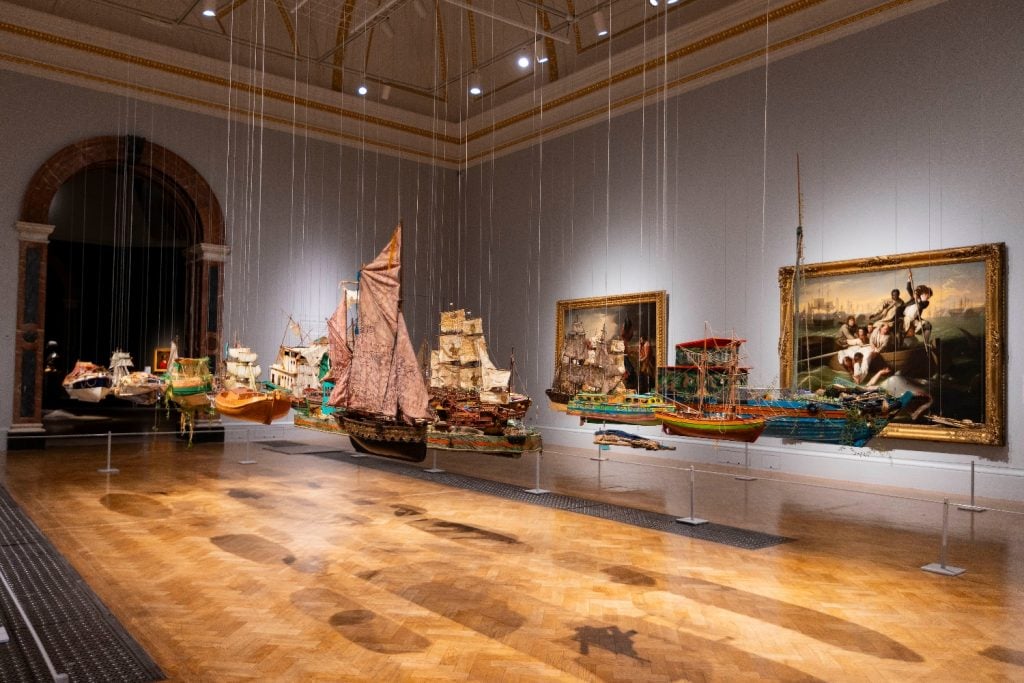
Installation view of the “Entangled Pasts, 1768–now. Art, Colonialism and Change” at the Royal Academy of Arts, London, showing Hew Locke, Armada (2017–19). Photo: © Royal Academy of Arts, London / David Parry. © Hew Locke. All Rights Reserved, DACS 2024.
The floating fleet of ships in Locke’s Armada (2017-19) was the highlight of the Royal Academy’s “Entangled Pasts” exhibition. Each vessel represents a moment in history, from the Mayflower of 1620 to HMT Empire Windrush, bringing Caribbean passengers to Britain in 1948, and today’s cargo ships. Together, they capture the complex systems that underpin our globalized world. In 2022, two golden trophies for the Met’s Facade Commission invoked the violent ways in which many major museum collections are amassed.
Though Locke’s works inspire dialogue over straightforward judgement, the decision to invite him into the British Museum’s storerooms may still strike some as brave. How many more “messy histories” can the museum possibly want uncovered? Not least now it is being haunted by its more recent past.
“Fifteen years ago, people may have had a conversation about a show like this after a few bottles of prosecco, then thought ‘forget that, it’s never happening’,” said Locke. “It is quite a bold thing.” Before accepting the offer, he had some reservations. “I said look, I’ve got opinions and a practice that I need to protect. You’ve got things you need to protect. Let’s see where we can meet.”

Hew Locke, Indra Khanna, & Isabel Seligman in the British Museum’s Prints & Drawings Study Room, 2024. Photograph © Richard Cannon.
He added that he and his partner, the curator Indra Khanna, greatly enjoyed the experience and received useful suggestions from museum staff. “We weren’t treated like terrifying people who came in to slash and burn,” he joked.
In the show’s epilogue, Locke wanted to acknowledge his own position in the establishment by presenting his Order of the British Empire (OBE) medal, which he wishes stood instead for “Order of British Excellence.” It is installed beside a cast replica of an Ife head, made by British Museum in the 1940s when the original was on loan from the Ife National Museum in Nigeria. “It may not be ‘real,’ but maybe that’s okay,” said Locke in an accompanying wall text. “Could replicas replace restituted objects in museums?”
It’s not the artist’s job to give us the answers but, in “What have we here?,” Locke encourages us to keep asking questions.
“Hew Locke: what have we here?” is on view at the British Museum in London through February 9, 2025.

